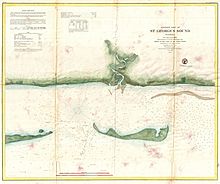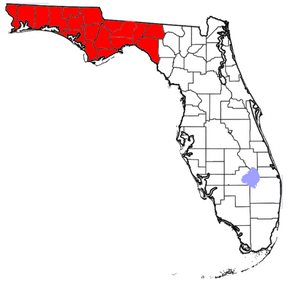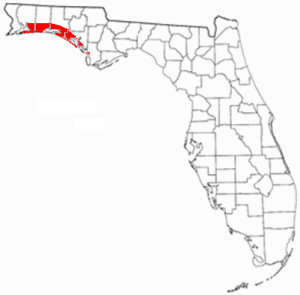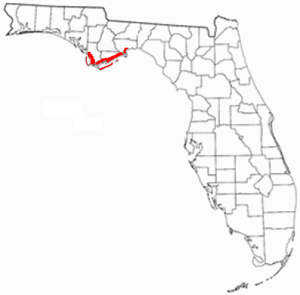Florida panhandle facts for kids

The Florida Panhandle is the northwestern part of the U.S. state of Florida. It's also known as West Florida or Northwest Florida. This area is a long, narrow strip of land, about 200 miles (320 km) long. It shares borders with Alabama to the north and west, and Georgia to the north. To the south, it's bordered by the Gulf of Mexico.
The exact eastern edge of the Panhandle isn't strictly defined. This region is known for its "southern culture" and more rural feel compared to the rest of Florida. It also has stronger cultural ties to nearby states like Louisiana, Mississippi, and Alabama. Some of its main cities include Pensacola, Navarre, Destin, Panama City Beach, and Tallahassee.
Like other U.S. states with "panhandles," the exact meaning of the term can change. However, the Florida Panhandle always includes the ten counties west of the Apalachicola River. This river is a natural border that historically separated the British colonies of West Florida and East Florida. These western counties are mostly in the Central Time Zone. The rest of Florida is in the Eastern Time Zone. Sometimes, the Panhandle can also include some or all of the eleven counties east of the Apalachicola River, known as the Big Bend region.
The Panhandle, like the rest of North Florida, feels more like the Deep South in its culture and climate than central or south Florida. It's known for its traditional values and "piney woods" (forests).
The largest city in the Panhandle is Tallahassee, which is also Florida's capital. In 2020, its population was about 196,169. However, the largest city west of the Apalachicola River is Pensacola, with a population of about 54,312 in 2020. Pensacola also has the largest metropolitan area in the Panhandle, with over 511,502 people. This area includes Pensacola and Navarre. In 2010, the total population of the Panhandle was about 1.4 million people. This is less than 7.5% of Florida's total population. The area is also less crowded than the rest of Florida.
Contents
Coastal Areas
Emerald Coast
The term Emerald Coast was first used in 1983. It generally refers to the beautiful beaches and coastal resorts from Pensacola to Port St. Joe. Sometimes, it's used to describe the entire Panhandle, especially the western part. Older names for this area included "Playground of the Gulfcoast" and the "Miracle Strip."
The coastal parts of these counties are usually considered part of the Emerald Coast:
Coastal areas of Bay County are also often included, but less consistently than the four counties listed above.
Forgotten Coast
The Forgotten Coast is a special name used since the early 1990s. It describes the coastal part of the Florida Panhandle from Mexico Beach (or southeastern Bay County) on the Gulf of Mexico to St. Marks on Apalachee Bay. This area is usually not considered part of the Emerald Coast, which is located directly to its west.
The coastal parts of these counties are typically included when talking about the Forgotten Coast:
- Gulf County
- Franklin County
- Wakulla County
- Small parts of Bay County
Natural Features
The Apalachicola River is the biggest river in the Panhandle. It forms where several rivers meet, including the Chattahoochee and the Flint. This meeting point is where the borders of Alabama, Georgia, and Florida come together. From there, the river flows south to the town of Apalachicola.
Major estuaries (areas where rivers meet the sea) in the Panhandle include:
- Perdido Bay, fed by the Perdido River, which forms Florida's western border.
- Escambia Bay and East Bay, fed by the Escambia River and Blackwater River.
- Choctawhatchee Bay, fed by the Choctawhatchee River.
- St. Andrews Bay, fed by Econfina Creek.
Pensacola Bay, a deepwater port, is formed when Escambia and East bays join. The Gulf Intracoastal Waterway, completed in 1949, runs through the lower Panhandle. It uses bays, lagoons, sounds, and canals built by people. The barrier islands of Perdido Key and Santa Rosa Island stretch from the western end of the Panhandle to Destin.
Britton Hill is the highest natural point in Florida. It is 345 feet (105 meters) above sea level.
History of the Panhandle
19th Century
During the 1800s, the Panhandle didn't have many people. It had small farming communities, but none had more than a thousand residents. Many people in the Panhandle had moved there from Alabama and had family there. It was also easier to travel and trade with southern Alabama than to reach East Florida. Traveling to East Florida meant a long, difficult journey through thick swamps and dense pine forests. Because of this, people in West Florida often felt they had more in common with their neighbors in Alabama than with people hundreds of miles away in the Florida peninsula.
In 1821, Pensacola was the only city in West Florida, with about 3,000 people. By 1850, Pensacola's population was 2,164.
Ideas to Join Alabama
Throughout the 1800s, there were often ideas to make the Florida counties west of the Apalachicola River part of Alabama.
- In 1811, when Florida was still owned by Spain, American settlers asked the U.S. Congress to let them join the Mississippi Territory (which included present-day Alabama).
- In 1819, Alabama's leaders asked Congress to include West Florida in their new state.
- In 1822, just one year after the U.S. bought all of Florida from Spain, West Florida residents asked to join Alabama. Alabama Senator John Williams Walker also supported this idea.
- In 1826, the Pensacola Gazette newspaper published letters supporting the idea.
- In 1840, people in Pensacola held a public meeting and demanded that West Florida join Alabama. The Florida Legislature at first opposed this, but in 1844, they changed their minds and asked for West Florida to be separated.
- In 1856, a bill was passed to let people vote on the issue, but the governor stopped it.
- In 1858, Alabama tried to talk with Florida about it, but nothing happened.
The Civil War (1861-1865) put these discussions on hold. But in 1868, after the war, Pensacola was connected by railroad to Mobile and Montgomery in Alabama. The idea came up again and was put to a vote. Alabama offered Florida one million dollars if West Florida joined them. On November 2, 1869, the people in West Florida voted 1162 to 661 in favor of joining Alabama. However, Alabama's leaders thought the price was too high, so they didn't act on the vote.
Later, in 1873 and 1901, Alabama made other offers, but none of them worked out.
The building of the Pensacola and Atlantic Railroad in 1883 finally connected Pensacola and the Panhandle with the rest of Florida. This helped end the region's isolation. Even so, there were still occasional talks about joining Alabama in the 1900s, but no official action was taken.
20th Century
In the last 25 years of the 1900s, several hurricanes hit the area and caused a lot of damage. These included Hurricane Eloise in 1975, Hurricane Kate in 1985, and Hurricane Erin and Hurricane Opal, both in 1995.
The Panhandle was also hit hard by the "Storm of the Century" in March 1993.
21st Century
The Panhandle was directly hit by Hurricane Ivan in 2004 and Hurricane Dennis in 2005. Ivan was the most damaging. It hit near Gulf Shores, Alabama, with strong winds and a 14-foot (4.3-meter) storm surge. This surge destroyed parts of Perdido Key and Santa Rosa Island. It also wrecked the Interstate 10 bridge over Escambia Bay and destroyed thousands of homes.
On June 23, 2010, oil from the Deepwater Horizon oil spill reached Pensacola Beach and Navarre Beach. This hurt the fishing and tourism industries and led to a huge cleanup effort.
On October 10, 2018, Hurricane Michael hit the Panhandle directly with winds as high as 160 mph (257 km/h). Michael was one of only four Category 5 hurricanes to ever hit the U.S. mainland. Thousands of homes were destroyed. Rent prices in Panama City doubled in 2019. Recovery from Hurricane Michael was still ongoing in June 2019.
Economy
Historically, the Panhandle's economy relied on farming, forestry (cutting down trees), lumbering (making wood products), paper mills, and shipping at Pensacola and Panama City. Shipbuilding and commercial fishing were also important. After World War II, the economy grew thanks to many military bases built in the region. Tourism and the hospitality industry (hotels, restaurants) also became very important.
Besides military bases, state and local governments, hospitals, schools, and colleges are major employers. In the second half of the 1900s, big private companies like Monsanto and Westinghouse (in Pensacola), the St. Joe Paper Company (in Port St. Joe), and Gulf Power (an electric company) also provided many jobs.
Unlike central and southern Florida, the Panhandle has never grown many citrus fruits like oranges. This is because the area gets regular frosts and freezes in winter, which would destroy citrus crops.
Transportation
Roads
Interstate 10 is the only interstate highway in the Panhandle. It connects the far western part of the region to North Florida and Jacksonville. Other important east-west roads include U.S. Highway 90 and U.S. Highway 98.
Important north-south roads west of the Apalachicola River include U.S. Highway 29, U.S. Highway 331, and U.S. Highway 231. These all connect to Alabama and Interstate 65. State Road 20 runs from Niceville to Tallahassee.
Railroads
Freight train service is provided by the Class III Florida Gulf & Atlantic Railroad. This company took over most of the CSX main line from Pensacola to Jacksonville in 2019.
Passenger train service ended in 1971. It was brought back in 1993 when the Sunset Limited train extended its route to Orlando. However, passenger service stopped again after Hurricane Katrina hit the Gulf Coast in 2005. Other smaller railroads serving the Panhandle include the Alabama and Gulf Coast Railway, the Bay Line Railroad, and the AN Railway.
Airports
Major airports in the Florida Panhandle include:
- Pensacola International Airport
- Destin-Fort Walton Beach Airport
- Northwest Florida Beaches International Airport
- Tallahassee International Airport
- Bob Sikes Airport
- Destin Executive Airport
- DeFuniak Springs Airport
- Apalachicola Regional Airport
- Perry-Foley Airport
Education
Here are some of the colleges and universities located in the Florida Panhandle:
State University System:
- Florida Agricultural and Mechanical University (Tallahassee)
- Florida State University (Tallahassee)
- University of West Florida (Pensacola)
Florida College System (Community Colleges):
- Chipola College (Marianna)
- Gulf Coast State College (Panama City)
- Northwest Florida State College (Niceville)
- Pensacola State College (Pensacola)
- Tallahassee Community College (Tallahassee)
Religiously affiliated colleges:
- Baptist College of Florida (Graceville)
- Pensacola Christian College (Pensacola)
Culture and Sports
The Panhandle is home to various cultural events and sports teams:
- Great Gulfcoast Arts Festival
- Florida A&M Rattlers (sports teams)
- Florida State Seminoles (sports teams)
- Pensacola Blue Wahoos (baseball team)
- Pensacola Ice Flyers (hockey team)
- Red Hills Horse Trials (equestrian event)
- Springtime Tallahassee (festival)
- Tallahassee Wine and Food Festival
Counties of the Panhandle
The following counties are always included when people talk about the Florida Panhandle. They are all located west of the Apalachicola River:
Some or all of these counties, located east of the Apalachicola River in the Big Bend area, are sometimes also considered part of the Panhandle:
Cities and Towns
Here are some of the cities and towns in the Florida Panhandle. Places marked with an asterisk (*) are east of the Apalachicola River and might not always be considered part of the Panhandle by everyone.
- Apalachicola
- Blountstown
- Bonifay
- Brent
- Callaway
- Carrabelle*
- Cedar Grove
- Century
- Chipley
- Crestview
- Cross City*
- DeFuniak Springs
- Destin
- Fort Walton Beach
- Gulf Breeze
- Jay
- Lynn Haven
- Madison*
- Marianna
- Mexico Beach
- Milton
- Niceville
- Panama City
- Panama City Beach
- Paxton
- Pensacola
- Port St Joe
- Quincy*
- Springfield
- Tallahassee*
- Valparaiso
Here are the populations of the major metropolitan areas in the Panhandle:
- Pensacola-Ferry Pass-Brent Metropolitan Statistical Area – 455,102 (2009)
- Fort Walton Beach-Crestview-Destin, Florida Metropolitan Statistical Area – 180,822 (2010)
- Panama City-Lynn Haven-Panama City Beach Metropolitan Statistical Area – 202,236 (2020)
- Tallahassee Standard Metropolitan Statistical Area – 367,413 (2010)
Beautiful Beaches
The Panhandle is famous for its white sand beaches and clear blue-green waters. These beaches are found on its barrier islands along the Gulf of Mexico. The sand is made of fine quartz that came from granite in the Appalachian Mountains. Rivers carried this sand to the sea, and currents deposited it along the shore.
Some of the beach towns in the Panhandle are popular with college students during spring break. The area is sometimes jokingly called the Redneck Riviera. This term was even used as a song title by country music artist Tom T. Hall.
Tourists have been coming to the Panhandle since the Pensacola and Atlantic Railroad was built in the 1880s. Pensacola Beach became a big tourist spot after bridges connected the mainland to Santa Rosa Island in 1931. After World War II, more tourists and people moved to the area. This led to many motels, restaurants, bars, and amusement parks along the coast, especially in Pensacola Beach, Fort Walton Beach, and Panama City Beach. Examples include the Gulfarium marine park in Fort Walton Beach and the former Miracle Strip Amusement Park (1963–2004) in Panama City Beach.
In 1971, the U.S. government bought many acres of coastal islands in Escambia, Santa Rosa, and Okaloosa counties. They protected these lands from development by creating the Gulf Islands National Seashore. This park also includes some islands off the coast of Mississippi. Other beach areas protected by the state of Florida include:
- Perdido Key State Park
- Big Lagoon State Park
- Henderson Beach State Park
- Grayton Beach State Park
- St. Andrews State Park
- St. Joseph Peninsula State Park
- St. George Island State Park
Both state and federal parks offer places for camping, picnicking, and other fun activities. Also, some parts of the coastline are owned by the military, such as Pensacola Naval Air Station, Eglin Air Force Base, and Tyndall Air Force Base. These areas are also protected from development.
In addition, seven state aquatic preserves, which cover thousands of acres of underwater lands, are located in the Panhandle. Many other state parks, preserves, and forests are found inland.
The 1970s also saw the start of many upscale beach resorts, condominium towers, vacation homes, and planned communities like Seaside and Sandestin. Now, most of the privately owned coastal areas are heavily developed.
Military Bases
The Florida Panhandle is home to several important military bases:
- Pensacola Naval Air Station (where Naval Aviation in the United States began)
- Eglin Air Force Base and Hurlburt Field (near Ft. Walton Beach)
- Naval Support Activity Panama City (in Panama City Beach)
- Tyndall Air Force Base (near Panama City)
Smaller military bases in the Panhandle include the Center for Information Warfare Training in Pensacola, Naval Air Station Whiting Field near Milton, and Duke Field near Crestview.
The TV show Emerald Point N.A.S. (1983-84) was set at a naval air station similar to Pensacola NAS. The action/adventure series Pensacola: Wings of Gold (1997-2000) was specifically set there.
See also
 In Spanish: Mango de Florida para niños
In Spanish: Mango de Florida para niños





